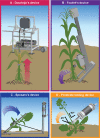Field-based mechanical phenotyping of cereal crops to assess lodging resistance
- PMID: 32995102
- PMCID: PMC7507486
- DOI: 10.1002/aps3.11382
Field-based mechanical phenotyping of cereal crops to assess lodging resistance
Abstract
Plant mechanical failure, also known as lodging, is the cause of significant and unpredictable yield losses in cereal crops. Lodging occurs in two distinct failure modes-stalk lodging and root lodging. Despite the prevalence and detrimental impact of lodging on crop yields, there is little consensus on how to phenotype plants in the field for lodging resistance and thus breed for mechanically resilient plants. This review provides an overview of field-based mechanical testing approaches to assess stalk and root lodging resistance. These approaches are placed in the context of future perspectives. Best practices and recommendations for acquiring field-based mechanical phenotypes of plants are also presented.
Keywords: anchorage; bending; lodging; phenotyping; rind penetration; root; stalk.
© 2020 Erndwein et al. Applications in Plant Sciences is published by Wiley Periodicals LLC on behalf of Botanical Society of America.
Figures




References
-
- Anderson, B. , and White D. G.. 1994. Evaluation of methods for identification of corn genotypes with stalk rot and lodging resistance. Plant Disease 78(6): 590–593.
-
- Arihara, J. , and Crosbie T. M.. 1982. Relationships among seedling and mature root system traits of maize. Crop Science 22(6): 1197–1202.
-
- Baker, C. J. 1995. The development of a theoretical model for the windthrow of plants. Journal of Theoretical Biology 175: 355–372.
-
- Barrerio, R. , Carrigan L., Ghaffarzadeh M., Goldman D. M., Hartman M. E., Johnson D. L., and Steenhoek L.. 2008. Device and method for screening a plant population for wind damage resistance traits. US Patent USPTO 7412880B2 [filed 13 October 2006; issued 9 August 2008].
-
- Berry, P. M. 2013. Lodging resistance in cereals In Christou P., Savin R., Costa‐Pierce B. A., Misztal I., and Whitelaw C. B. A.eds.], Sustainable food production. Springer, New York, New York, USA.
Publication types
LinkOut - more resources
Full Text Sources
Other Literature Sources

